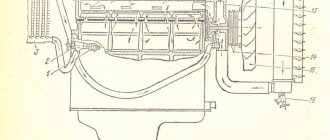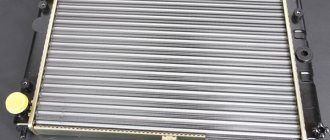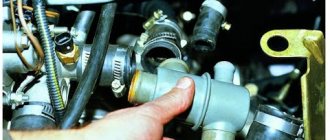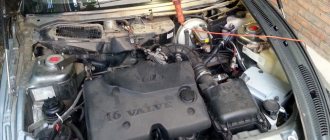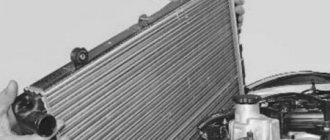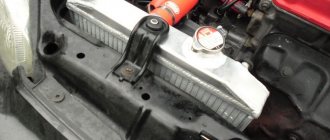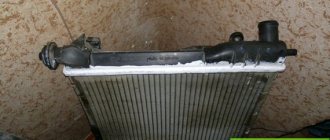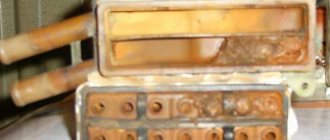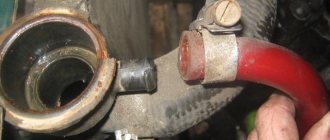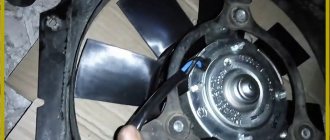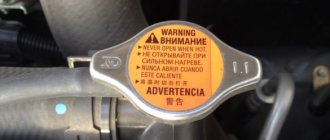About once every 2 years, many motorists begin to remember the proportions for flushing the engine cooling system with citric acid. Despite the abundance of all kinds of chemicals created for this purpose and advertised by manufacturers, proven folk methods remain in the lead.
Firstly, because they are relatively harmless. You won’t get a chemical burn from the same lemon and you won’t inhale harmful fumes. And it does not have a decomposing effect on the components of the cooling system.
Secondly, many generations before us were convinced of their effectiveness. Thirdly, lemon is perfect for any radiators - from aluminum to brass. Fourthly, it costs mere pennies, which cannot be said about modern chemistry. The only inconvenience is that, unlike branded formulations, exact instructions on how to rinse are not included with the citric acid sachets. You need to remember how much is required, or act at random, empirically calculating the consistency.
Proportions for flushing the engine cooling system with citric acid
: what they are is a rather controversial question. Many who have used it have their own opinion on this matter. However, let's try to establish the best ratio.
When is it time to go get some lemon?
Of course, a decent owner regularly washes the insides of his car and does not bring them to a sad state. However, if you, for example, are not the first owner of the car and do not know when the washing procedures were carried out, you should think about them if:
- the pump began to function worse;
- the system’s response to switching the rheostat is not entirely adequate;
- The readings on the temperature sensor fluctuate or it consistently shows that the temperature is too high;
- the stove is not working well;
- The fan operates constantly at high speeds.
If these signals are ignored, the next stage will be boiling of the coolant.
It is not difficult, although it can take up to a day if it has not been done for too long. But first, let's deal with concentration. We found too many options, and the range in the amount of lemon is simply amazing: from a 1:2 ratio to a pack for 5 liters of water. True, in the latter case it is not clear which pack exactly: citric acid is packaged in 30 and 80 g packs. Therefore, we followed the path of logical thinking. Lemon has long been used to clean the insides of teapots.
With a vessel volume of 2 liters, one 30-gram sachet is enough. Accordingly, if rinsing requires 8 liters of water, 4 packages should be dissolved in it. The cleaning procedure itself will look like this.
- Purchase distilled water. And you shouldn’t skimp on this: it’s hardly wise to add new ones to existing layers.
- A small amount of it (a glass or a half-liter jar) is boiled; this is necessary for more complete dissolution of the acid. The purchased lemon is poured in, the solution is cooled;
- Antifreeze is drained. It’s a good idea to take a close look at how well it’s worked out. If the color does not bother him too much, the concentration of the solution can be reduced - your system is not too dirty. If antifreeze looks more like autumn mud, you can add a couple more packets of acid;
- The system is purged through the expansion tank. This must be done to ensure that there is no antifreeze left in it. Moreover, the blowing is repeated several times at minute intervals;
- Instead of antifreeze, the prepared solution is poured;
- The engine starts, warms up until the thermostat opens, and then idles for about 10 minutes. You can rev it up a couple of times. When hot, lemon has a more active effect;
- The solution is drained; his appearance is assessed. If the flushing is not very different from the previously drained antifreeze, the procedure is repeated;
- When the solution comes out in almost the same form in which it was poured in, the system is washed with distilled water 2-3 times, after which fresh antifreeze can be added.
Flushing the engine cooling system is one of the simplest procedures that even a beginner can handle. Moreover, if you figure out how to flush the engine cooling system with citric acid, you can save not only on workshop services, but also on expensive reagents.
The car cooling system does not require constant monitoring. As long as the machine is working properly, it is enough to flush the system no more than once every two years. But if the temperature sensor readings are too high, the engine gets very hot, the fan is noisy, the pump is acting up or the stove is not working well, then it is better not to put off washing.
Why should you flush the cooling system with citric acid?
From the wide selection of reagents on the market, at home it is better to give preference to “folk” and proven methods. Here is a list of the main advantages why you should use citric acid and not any other cleaning chemical:
- Firstly, it will significantly reduce costs.
- Secondly, you won’t have to breathe chemical fumes.
- Thirdly, citric acid does not corrode metal and is suitable for any type of radiator.
- Fourthly, this natural reagent copes well with the most severe dirt and even scale.
- Fifthly, cleaning occurs gently, without destroying the system or wearing out vehicle components.
How to flush the engine cooling system with citric acid?
However, there is a lot of controversy about how to flush the engine cooling system with citric acid. After all, the main thing is to do it right. Although it is not at all necessary to measure proportions in grams. However, you need to adhere to certain quantitative indicators of the concentration of citric acid, so you can avoid unnecessary problems and losses. To do this, you need to remember just two things:
- Too low a concentration of citric acid will not give the desired effect;
- Excessive consumption of lemon juice can damage the system.
The best option would be to use 30 grams of acid per 2 liters of distilled water. In order to flush the system, 10 liters of liquid is enough. This means that we will need about 150 grams of citric acid to completely clean the cooling system.
Preparation before starting work
In general, the procedure for cleaning the engine cooling system with citric acid is not much different from conventional flushing work. Before you start washing, purchase distilled water (available at any parts store). It costs a penny, so saving on water by clogging the system with new salt deposits is not advisable.
We heat some of the water, dissolve the entire volume of citric acid in it and wait until the liquid cools again. At this time, you can start draining the antifreeze. To do this, a protective shield is unscrewed from the bottom of the machine. Below it you will see the radiator cap. If the coolant was added recently and you plan to use it after flushing, then before opening the valve on the radiator, you need to place a container to collect the antifreeze. You can also use the container for neatness purposes.
But whether to fill the cooler back or not will become clear as soon as you see the color of the liquid. Used antifreeze has a dark (dirty) color. You can control the rate of fluid drainage by unscrewing or tightening the plug on the expansion tank. After draining the liquid, to be more sure that there is no more antifreeze, the system can be purged through the expansion tank. Blowing is carried out in 3-4 approaches with an interval of several minutes.
Next, we proceed directly to the question of how to flush the engine cooling system with citric acid. While the antifreeze was draining, the water with citric acid dissolved in it cooled. Now you can mix it with the remaining water, close the radiator cap and pour the mixture into the system. After this, we start the car and warm it up, first at idle, and then slightly increasing the gas for 10-15 minutes.
Flushing the engine cooling system yourself.
The products used to flush the engine cooling system use both special chemicals and folk ones. Folk remedies for cleaning the system are inexpensive and proven many times. Acid-containing products can remove rust and such deposits, and alkaline products can remove scale.
Consider washing with citric acid.
Since citric acid (formula C6H8O7) is capable of corroding rust and deposits of oxidized metals, it can be used effectively if water was used as a coolant in the engine cooling system.
How to dilute citric acid for flushing radiators:
- Take one liter of clean water.
- Add 20-40 grams of citric acid powder (1-2 tablespoons) to this water - this is for easy cleaning or prevention. If the system has not been washed for a long time or is heavily contaminated, then you need to add 80-100 grams of citric acid (8-10 tablespoons) per 1 liter of water. For the water to become strongly acidic rather than alkaline, that is, the pH level should be less than 7. If you add this amount of citric acid to distilled water, the pH level will be about 3.
- Make a volume of the finished liquid that will fit into the empty cooling system. Depending on the engine. How many liters of antifreeze, water or antifreeze were poured, the same volume should be used to prepare a cleaning liquid. That is, to prepare 10 liters of lemon aggressive liquid, you will need 10 liters of distilled water and 0.8-1 kg of lemon powder.
Follow by flushing the cooling system:
- Completely drain the coolant from the system.
- Pour in the prepared solution.
- Start the engine, heat to operating temperature and leave for several hours.
- Drain the cooling system.
- If the liquid is very cloudy and dirty, then rinse again until the liquid becomes clear.
- After the drained flushing liquid turns out to be clean, it is imperative to rinse the system with ordinary clean water (preferably distilled or boiled).
The next common folk remedy for flushing the engine cooling system is acetic acid.
An acetic acid solution effectively removes rust. To prepare the washing solution you will need:
- 10 liters of clean water;
- 0.5 liters of vinegar.
The replacement procedure is the same as using citric acid:
- drain;
- pour;
- start the engine;
- let the engine run for about 1 hour;
- drain;
- repeat until the liquid is clear;
- rinse with distilled or boiled water;
- Fill in new antifreeze or antifreeze.
Another folk remedy used as a flushing fluid for all channels of cooling systems is the carbonated drink Fanta.
Fanta contains citric acid. Therefore, some home craftsmen also use it for cleaning. They drain the old fluid, fill the entire system with this phanta, then let the engine run for about an hour at idle speed, or, if it is heavily contaminated, they operate the car with the phanta filled in for a couple of days. Then drain and fill with distilled water, and also operate for two days. Then drain and look at the condition of the liquid. If necessary, carry out the procedure until the drained liquid becomes relatively clean.
After flushing, you need to check all the cooling system pipes and the radiator. It happens that rust blocked the holes and the system remained sealed. But after flushing, the radiator or pipes may leak.
Flushing the cooling system with lactic acid or whey.
A less common option is to use whey or lactic acid as a flushing fluid for the engine cooling system.
If lactic acid is available, the entire system is filled with it. Start the engine and allow it to idle or under load for some time.
But not everyone has the opportunity to use lactic acid for washing. Therefore, whey is used instead.
The sequence of flushing the cooling system with serum:
- Find or prepare 10 liters of whey.
- Strain several times to avoid any pieces of fat.
- Drain the old coolant.
- Pour in the serum.
- Start the engine and hit the road. Drive 50 kilometers, but drive no more than 2 hours. Because the serum loses its main good properties after 2 hours.
- Wear thick rubber gloves to avoid getting burned.
- Drain off the hot whey. If it cools down, then deposits will again form on the walls of the channels and the jacket of the cooling system.
- After draining, allow the engine to cool.
- Pour pre-boiled water into the system.
- Start the engine.
- Let it work for 20 minutes.
- Drain the water.
- Fill with fresh antifreeze G11, G12, G12+ or G13. It is better to fill from G12 and above.
- Get the air out. This also requires certain knowledge - how to remove an air lock from the cooling system.
- Check the level, top up if necessary.
Why flush the engine cooling system?
The answer to the question is obvious: to restore its lost characteristics, improve the circulation of coolant, and stabilize the temperature regime of the engine.
Auto mechanics recommend using water first. If the degree of contamination of the cooling system is low, this will help remove all that is unnecessary and extend the life of individual components. But if the car has been in operation for five years or more, and even more so, not from a car dealership, and has changed several owners, then there is a high probability that the cooling system is not as fresh as in previous years.
Some car owners do not repair the system when there are small leaks, but simply add sealant to the coolant. It copes well with small cracks, but at the same time it can clog radiator tubes, damage the thermostat and cause a lot of other troubles if used ineptly.
Flushing the engine cooling system.
Antifreezes generally have a service life of 5 years or until the engine travels 250 thousand km. Antifreeze has a service life of 2-3 years. By the way, you can see what happens if you mix antifreeze with antifreeze. Depending on the operation of the vehicle and the quality of the coolant, if the coolant is not changed or if the coolant is diluted, the radiator channels and cooling jacket become clogged. Therefore, to increase the overhaul life of the engine, it is necessary to periodically flush the engine cooling system. You can wash it both in car services and at home in your own garage.
How can you tell if your cooling system needs flushing?
It is worth paying attention to the color of the coolant. The method depends on the design of the cooling system of your car. For example, on domestic VAZ cars, the reservoir is part of the circulation system - the fluid flows through it, and the condition of the fluid is easy to assess by removing the lid and looking inside.
ATTENTION!
All manipulations can only be carried out with a cooled engine. If you open an expansion tank with hot coolant, it may boil and splash out.
On foreign cars, the tank can be constructed as a separate element, through which there is no circulation. The expansion tank pipe comes out of the radiator filler neck. A certain level must be maintained in the tank. If the pressure in the system increases, excess liquid is sent through the pipe into the tank. If a vacuum is created, the system takes the missing volume of liquid from this tank.
In the second case, looking at the liquid in the tank may not give a complete picture of the condition of the cooling system. Therefore, it is necessary to drain a little coolant through the radiator fitting and check its quality.
Coolants are produced in three colors: blue antifreeze, antifreeze can be red, orange or green (less often blue, yellow). In any case, if the coolant has been changed regularly and the system is not seriously contaminated, you can visually determine what kind of liquid it is. If there is dirty liquid in the system, this is a clear signal to at least replace the coolant and flush the cooling system with water.
How to flush the cooling system when changing the fluid?
If the check reveals that the coolant has an uncharacteristic color, or the engine begins to overheat in hot weather, then it is necessary to drain the old coolant and flush the system with water. You can find the volume of the machine's cooling system in the owner's manual or on the Internet. Usually this is about 7-8 liters for common engines with a volume of 1.5 - 1.6.
Flushing the system with water is simple: fill in the required flush volume, start the engine and wait for the thermostat to open. Let the engine idle for 10 minutes. After this, turn off and let cool. Then the water must be drained and, if possible, the system must be purged with a compressor. If the water is dirty, repeat the procedure.
At the end of the flushing, coolant is added. Every 100 kilometers you need to check its level, the absence of leaks at the joints of the system, and observe the color of the liquid. If it changes again, the system needs more serious flushing.
Flush the cooling system with citric acid solution
Many people believe that this cleaning method is too aggressive on radiator tubes and rubber hoses. It is not true. The concentration of citric acid in the solution is small.
Solution proportion: one sachet of citric acid per five liters of water. It is sold packaged in 80-100 grams in grocery stores. It's better to stock up on a dozen of these bags. It is not a fact that the solution will be able to remove all deposits from the system the first time.
It’s easy to flush the engine cooling system yourself with citric acid - the process is no different from flushing with water: add the solution, start the engine, wait for the thermostat to open, let it idle for another 10-15 minutes, turn it off, cool, drain.
After draining, it is necessary to evaluate the condition of the solution. If a layer of sediment has accumulated at the bottom of the container where it is poured, the procedure will have to be repeated. This must be done until the drained solution is as clean as possible.
There is an opinion that it is better to change the proportion in favor of reducing the acid content - add half or ¾ of a bag instead of the whole. This reduces the likelihood that scale in the system will begin to fall off in pieces and clog the radiator tubes. If it is impossible to accurately assess the degree of contamination, it is better to do just that. It is enough to reduce the concentration of citric acid in the water, but increase the number of washes.
At the end of the process, be sure to flush the cooling system with clean water, as described above. If you have a compressor at hand, blow it out. And after that you can fill in new coolant.
According to car owners who have performed this procedure, the system really begins to work better after washing with a solution of citric acid. And if in winter the stove did not warm up the interior, then washing it perfectly corrected this shortcoming.
The main thing is to check at all stages of flushing whether leaks have appeared at the junctions of system elements.
It is likely that there was sealant in it before. And washing will remove it. If a leak does appear, the problematic element should be repaired or replaced.
Flushing the cooling system with citric acid - personal experience
Replacing the heater radiator Lada Kalina
The need to flush the cooling system arises when replacing the coolant with a liquid of a different brand or when you notice unsatisfactory operation of the system. A considerable number of reagents are produced for this purpose, however, many drivers use improvised means. Having unsuccessfully flushed the cooling system with a store-bought compound, I tried citric acid.
To begin with, having decided to use citric acid, I bought one bag and rinsed the kettle with it. The method is widely known: fill the kettle with water, add a packet of acid and a piece of aluminum foil, boil, and leave to stand for half an hour. We admire the clean teapot and untouched foil. Over a cup of tea, we ponder the results of the experiment.
- Citric acid is safe for aluminum radiators, but removes scale. The silicate film in the cooling system is not scale.
- For a 1.7 liter kettle, 1 sachet weighing 30 grams is enough. This means that for a cooling system with a volume of 8 liters you need 4...5 bags. (I took 10 bags, maybe that's too much).
After rummaging around in the kitchen, I found a jar with a volume of about a liter. I poured acid from sachets into a jar and poured boiling water over it. Having loaded the trunk with containers of water, I went to the washing place.
To flush the cooling system, the antifreeze must be drained. I was going to pour it back in later. Therefore, it was necessary to drain the antifreeze clean. I reached under the car and unscrewed the mudguard. He placed the basin. I unscrewed the cap on the radiator. (It is convenient to regulate the fluid flow rate using the expansion tank plug). Drained from the block.
I poured the washing solution: first diluted citric acid, then just water according to the level. I started it, warmed it up to 50 degrees at idle, then added gas, accelerated the engine to three thousand revolutions and warmed it up to one hundred degrees. This took about 10...15 minutes. I warmed it up at high speeds so that there was good circulation through both the radiator and the stove. The engine was turned off, slowly cooled down and gurgled with escaping gases.
Ten minutes later, when I started it, I noticed a rapid increase in temperature. This is a sign of lack of circulation! Immediately turned it off. Opening the hood, I discovered an increased fluid level in the reservoir. The released gases displaced the water into the tank. I removed one hose for heating the throttle assembly - the level dropped. Then I did just that: I warmed it up, turned it off and immediately removed the hose of the throttle assembly - so that gas could escape freely. I didn’t leave the parking lot - I shouldn’t let off the gas at every intersection.
An hour later, I poured it into the washing solution and washed it four times with just water (the blackness in the drained water disappeared the third time).
My conclusions are as follows
To flush the cooling system, the exposure time of the solution is important. Simple citric acid is a cheap and reliable means of flushing the cooling system.
Use it first, and only then branded products, the composition of which is unclear. When flushing the cooling system, do not limit yourself to idle speed, drive the engine at three thousand - to create a strong circulation of the flushing solution.
And a few more interesting ways:
Heater maintenance intervals
Most of the time, the antifreeze in the cooling system operates at a temperature of 80–95 degrees. Deposits gradually accumulate on the internal surfaces of metal tubes in contact with outside air. The cross-section of the pipes for the flow of coolant decreases, and the intensity of heat exchange decreases.
Reasons for the formation of sediment that interferes with the normal heat transfer of radiators:
- untimely replacement of old antifreeze, whose additives have lost their working properties and have begun to precipitate;
- the use of tap and distilled water instead of antifreeze leads to increased deposition of salts (scale);
- filling with fake coolant;
- Small particles travel through the system, clogging the stove tubes - metal shavings, rust, pieces of sealant and rubber.
The optimal interval for flushing the stove radiator is once every 2–3 years. The operation is carried out simultaneously with the replacement of antifreeze - the system is emptied, filled with distilled water with a special cleaning agent and warmed up with the engine to operating temperature. Then the solution is removed and new antifreeze is poured through the expansion tank.
If the above-described preventive flushing has not been carried out for many years, to restore normal heat exchange, the heater radiator will have to be cleaned of scale and debris. To avoid having to disassemble the interior, wash the stove without removing it from the car using one of the two methods described below.
FAQ
What is the best way to clean a copper stove radiator?
The simplest method for flushing a copper car heater radiator is to use a 10 percent caustic soda solution (caustic soda, mole for flushing plumbing pipes). The hot solution is poured inside for 30 minutes, then drained. If necessary, repeat the procedure two or three times.
Washing with a mixture of citric acid and vinegar also shows good results. However, for an old copper radiator, it would be best to remove, unsolder it and mechanically clean it by hand.
What is the best way to clean an aluminum stove radiator?
To wash aluminum stove radiators, it is recommended to use acid-based products. The best options are whey, citric acid (such mixtures should only be very hot - 90°C) or phosphoric acid solution (heat to 40-50 degrees). And for a copper-brass heat exchanger, only professional products designed for flushing a car’s cooling system will be safe.
How to wash and what proportions for flushing the stove radiator with citric acid?
The proportion for flushing the radiator of a car heater with citric acid is 50 grams of acid per five liters of water. If the radiator is heavily clogged, the amount of acid can be increased to 80 grams. The acid is poured into 0.5 liters of boiled water, stirred until dissolved and then the bulk of distilled water is added.
The liquid is poured into the cooling system instead of antifreeze, the engine is warmed up to operating temperature, and then left to idle for another 15 minutes. Then drain and wash the system 3-4 times with distilled water.
How can I clean the heater radiator without removing it?
Alkaline, acidic or special cleaners are used to flush car interior heater radiators. Alkaline compounds remove scale (lime), and acidic compounds remove rust.
How much does it cost to flush a stove radiator at a service center?
It is necessary to understand that different services, including in different cities, may charge different prices for the service of cleaning the stove radiator without dismantling it. However, as of the summer of 2021, on average, the price of this procedure starts from 1,500 Russian rubles. As for the procedure time, it is about two hours. If the radiator is severely clogged, it may take more time, and the payment will increase, since more cleaning products and worker time will be spent.
How to wash the heat exchanger honeycombs?
To remove deposits and dirt from the interior heater radiator, the following chemical compounds can be used:
- car detergent sold in specialized stores (for example, from the Mannol brand);
- food grade citric acid;
- household reagents intended for cleaning sewer pipes;
- caustic soda solution.
Advice. Before purchasing a flushing solution, you should check what material your car’s heater is made of – aluminum or copper. Regents that clean copper tubes well can harm the aluminum honeycomb of the heat exchanger.
A radiator made of copper can be washed with all of the above means. The only caution: carefully read the instructions for the household reagent and make sure that the liquid will not damage rubber hoses and plastic parts. If the clog is severe, it is better to purchase two chemicals - acid-based and alkaline-based.
Since the aluminum stove radiator does not tolerate contact with alkali, it is worth purchasing citric acid or a factory-made automotive product designed for such heat exchangers. As a last resort, use weak alkaline solutions for a short time, followed by thorough rinsing with distillate.
Application of special auto chemicals
In specialized auto stores you can find various products designed for cleaning the cooling. Such auto chemicals are divided into four main types:
- alkaline;
- neutral;
- acidic;
- two-component.
Such products differ in their concentration of chemicals and the degree of influence on calcium deposits and internal engine elements. You just need to remember that it is prohibited to use several additives at the same time, since the active components enter into a chemical reaction with each other, and this leads to the appearance of a sediment, which is extremely difficult to get rid of in the future.
The domestic company LAVR offers high-quality, inexpensive chemicals designed to clean the cooling system. Buyers can choose several products, which are sold in 0.43 and 0.98 liter cans. The cost, depending on the volume and the specific outlet, can be 4-7 dollars per jar. Using auto chemicals is not difficult: the concentrate is diluted with warm water in a ratio of 1 to 20, poured into the expansion tank and start the engine for 15-20 minutes. The advantages of such a tool include its versatility, effectiveness and affordable cost.
American-made Hi-Gear 7 minute additives are very popular on the market. Auto chemicals are offered in 0.32 liter cans. This will be enough to prepare 17 liters of washing solution. This product is equally suitable for cars and trucks equipped with gasoline and diesel engines. The flushing time is 7 minutes, which allows you to remove all existing oily and calcium contaminants in the system.
The features of this product are its versatility of use and neutral effect on plastic and polymer engine parts.
Let's start with the fact that experts recommend flushing the engine cooling system every time you change antifreeze or antifreeze, in case of an unexpected increase in operating temperature and engine overheating, emergency malfunctions, etc.
As for flushing, there are several methods that allow you to remove scale, dirt, additive decomposition products and other various deposits from the channels of the cooling system, as well as from the surfaces of parts. There are a large number of special active formulations on sale.
At the same time, for one reason or another, many car enthusiasts prefer long-known and time-tested solutions instead of chemicals. As a rule, such solutions mean flushing the engine cooling system with whey or citric acid. Let's focus on citric acid and look at this method in more detail.
Read in this article
On-the-go preventative cleaning
This method is recommended to be implemented in the absence of frost - in summer, early spring or late autumn. The reason is to fill the cooling system of the power unit with distilled water for several days. Due to night frosts, heat exchanger tubes may crack due to ice expansion. It is permissible to carry out flushing activities in winter if the vehicle is stored in a warm garage and does not remain outside for a long time.
How to do this cleaning:
- Completely drain the engine cooling system.
- Take the required amount of distillate corresponding to the volume of the system. Heat the water and dissolve 100–150 grams of citric acid in it.
- Pour the product into the antifreeze area and make sure there are no air pockets.
- Ride in water with citric acid for 4-5 days, then drain the solution. Fill the engine cooling jacket and pipeline network with new antifreeze of a suitable brand.
Note. A food acid concentration of 100 grams per 10 liters of water is considered quite weak - the solution is unable to damage any parts or honeycombs of radiators.
Washing “on the go” is a preventative measure. A heat exchanger heavily clogged with scale cannot be cleaned using this method; a higher concentration of acid and backwashing are required.
Preparation for major flushing
To clean the interior heater radiator directly on the car you will need:
- There are two types of detergent – alkaline and acidic;
- standard set of keys, screwdrivers and pliers, funnel;
- a low-power water pump (a household circulation unit for heating and an electric pump from a Gazelle truck are also suitable);
- two hoses 2 meters long with tightening clamps;
- distilled water in an amount of 3 volumes of the cooling system of your car;
- boiler and bucket;
- old nylon tights or gauze folded in three.
Also prepare a container for draining old antifreeze and the required volume of fresh coolant. Often, car enthusiasts wash the heat exchanger of the stove without completely emptying the pipelines and engine jacket, but then all the debris contained in the old antifreeze will again flow into the clean radiator.
It is more convenient to carry out work in a garage equipped with an inspection ditch. To remove deposits without removing the heater from the car, completely drain the antifreeze from the engine in the following order:
- Allow the engine to cool to room temperature and place a container underneath for antifreeze.
- Unscrew the plug on the cylinder block with a wrench, then open the cap of the expansion tank.
- When all the antifreeze has flowed out, screw the plug back into place. If the main radiator has a second drain, repeat the operation.
- Disconnect the pipe at the highest point of the system - on the throttle valve or carburetor heating unit.
On some cars, emptying is prevented by covers that protect the engine compartment from dust from entering from below. There are 2 options to solve the problem: remove the protection or use a long hose attached to the neck after unscrewing the plug.
Work order
To clean the stove with your own hands, you need to find and disconnect 2 pipes leading from the engine compartment into the cabin. Point two: make sure that the heater valve located inside the cabin is open. Next, assemble a washing installation that includes the following elements:
- 2 hoses;
- water pump;
- pantyhose filter.
The purpose of the filter is to prevent dirt and scale particles from getting inside the pump unit, so it must be installed at the end of the hose coming from the heat exchanger. Connect the other pipe to a pump submerged in a bucket of washing solution. If you use a Gazelle pump or a circulation pump, you will have to install a short hose on the suction side to supply water from a bucket.
Before flushing the car heater radiator, connect the hoses of your homemade installation to the heat exchanger pipes. Then proceed according to the instructions:
- Using a boiler, heat the water in a bucket to a temperature of 70–85 °C.
- Turn on the pump by lowering the return hose into a bucket. When a steady flow comes out of it, add a “Mole” type drain cleaner or similar to the hot water (amount - at least 1 liter).
- Rinse the stove for 30 minutes, periodically turning on the boiler. Do not allow the solution to cool or boil.
- After half an hour, stop pumping and remove dirt from the filter. Then swap the suction and return hoses in any convenient way - switch the pipes on the machine or pump unit.
- Start pumping again. Reverse cleaning of the stove radiator is mandatory and lasts 30 minutes.
Important point! If the heat exchanger is made of aluminum alloy, the treatment time with sewage reagent should be reduced to 10–15 minutes. As a rule, such chemicals are made on the basis of alkali and can corrode the radiator honeycombs.
The second stage - washing the stove with clean water - is carried out in a similar way. First, water is supplied in one direction, then in the other, pumping time is 15 minutes. Then replace the filter and proceed to the third stage - acid treatment.
To clean the radiator with citric acid solution, pour 100–150 grams of the reagent into hot water and mix thoroughly. Connect all hoses and start the pump unit again. Removing scale with acid lasts from 30 to 60 minutes, depending on the degree of contamination of the internal surfaces of the heat exchanger. Remember to maintain the temperature of the solution and backwash (also 30–60 minutes).
Flushing the engine cooling system: citric acid as a cleaner
As mentioned above, the need to flush the cooling system may arise for various reasons. As a rule, cases when:
- the antifreeze in the expansion tank has darkened or become cloudy;
- “flakes” of scale and lumps of dirt are noticeable in antifreeze;
- the engine began to overheat regularly;
- The cooling fan operates frequently;
- there are problems with the operation of the thermostat;
- The interior heater (stove) is not working correctly, etc.
It is not difficult to guess that ignoring these symptoms will soon lead to more serious overheating of the internal combustion engine, which, in turn, will damage the engine. At the same time, a number of simple and accessible actions allow you to solve an existing problem yourself in advance, as well as avoid undesirable consequences in the future.
It is worth adding to this that the harmful effects of such a cleaner on the cooling system itself are similarly minimized. This means that citric acid, when used correctly, is not capable of harming parts, rubber pipes, seals, etc. In other words, the composition can be safely used for cleaning radiators, regardless of the material they are made of (aluminum, brass).
It is also worth highlighting the availability of the method, since citric acid is a cheap product, especially when compared with ready-made special cooling system cleaners from various domestic and foreign manufacturers. The main thing is that the car owner needs to know how to prepare a flush and flush the cooling system with it. In other words, you need to understand in what proportions to mix citric acid and water.
It should be noted that the proportions of citric acid in the solution for flushing the cooling system are relative. Moreover, the opinion of many car enthusiasts on this matter is somewhat different. However, one should not draw hasty conclusions, since it is a mistake to believe that the more acid, the better.
If you remember that to remove scale at home (for example, in a kettle), 1 30g sachet is enough. for a couple of liters of water, then we can conclude that for 5 liters. 70g will be enough. citric acid, that is, for one cleaning cycle it is advisable to immediately buy a large 80 g package.
If the cooling system is very dirty, then it is quite possible that it will have to be cleaned several times to achieve the proper effect. This means that you need to have at least two or even three large packages in stock.
Problem prevention
After completing the flushing, we recommend carefully monitoring the condition of the engine (in particular, the temperature). If noticeable heating occurs, it is necessary to immediately stop the vehicle, turn off the engine and carry out maintenance on the cooling system. Sudden temperature changes in most cases are due to the fact that the liquid inside the system does not circulate.
In extreme situations, contact a car service center for a comprehensive inspection and diagnosis of cooling system problems. Driving a car with high engine heating rates is extremely dangerous. It can lead to serious problems and the need for major repairs. Good luck on the roads!
Let's start with the fact that experts recommend flushing the engine cooling system every time you change antifreeze or antifreeze, in case of an unexpected increase in operating temperature and engine overheating, emergency malfunctions, etc.
As for flushing, there are several methods that allow you to remove scale, dirt, additive decomposition products and other various deposits from the channels of the cooling system, as well as from the surfaces of parts. There are a large number of special active formulations on sale.
At the same time, for one reason or another, many car enthusiasts prefer long-known and time-tested solutions instead of chemicals. As a rule, such solutions mean flushing the engine cooling system with whey or citric acid. Let's focus on citric acid and look at this method in more detail.
Read in this article
How to clean the cooling system with citric acid
If we talk about the washing procedure itself, then you should prepare water, citric acid, and also reserve time. The process is not complicated, however, it may well be labor-intensive.
- Please note that to prepare the rinse, you need to use distilled water, not running water. As a last resort, ordinary tap water needs to be boiled well, and only then mixed with acid and poured into the cooling system.
- To effectively mix water and acid, you need to take about 0.5 liters of water in a separate container, then this water should be boiled. After the water begins to boil, add citric acid. This allows the acid to dissolve well. Next, the resulting solution is cooled. After this, you can pour the prepared solution into the main volume of water, then mix again.
- Next, antifreeze or antifreeze can be drained from the cooling system, assessing the degree of contamination and condition by appearance (color, smell, impurities, etc.). If antifreeze or antifreeze is very dirty, then the water-acid solution should be saturated (about 80 g of acid per 5 liters of water). If the antifreeze is relatively pure, then 40-50g will be enough.
- Now, instead of antifreeze, flushing is poured into the expansion tank, the engine needs to be started and warmed up to operating temperatures at idle (until the thermostat opens and the cooling fan turns on).
- Usually, the engine runs for about 10-15 minutes to clean it, and you can also idle it further. When finished, the engine must be turned off.
- After the internal combustion engine has cooled slightly (15-20 minutes), the solution can be drained. At the same time, its color, condition, etc. should be assessed. If dirt is visible, then the flushing procedure must be repeated by pouring a fresh portion of cleaner into the system.
- A sign that the system has been cleaned will be a clean flush that is drained. Next, you should rinse the system 2-4 more times with distilled water, but without acid. Now you can add fresh antifreeze or antifreeze.
Special liquids for flushing the cooling system
Those who are not going to try drinks, descalers, as well as folk remedies as a cleaner and do not trust them, they choose auto chemical products.
Manufacturers of auto chemicals are constantly developing new products, so there is a wide range of choice.
Classification of liquids by chemical composition:
- Neutral. Neutral are those with pH = 7. You can buy a ph meter and check what kind of water we drink (it’s good to drink alkaline water), etc. Neutral liquids do not have various alkaline and acidic impurities. Such liquids by themselves cannot clean the cooling system channels well.
- Acidic. Such liquids have a pH value of 7. They effectively dissolve organic contaminants.
- Two-component. Such liquids contain both acidic and alkaline elements. Effectively dissolve and remove scale, rust, and various deposits resulting from the breakdown of antifreeze or antifreeze.
It is advisable to use only one liquid based on its chemical composition. Not so, first alkaline, then acidic, or vice versa.
Among the TOP auto chemical products for flushing the engine cooling system are the following:
- Lavr Radiator Flush Classic (Lavr Radiator Flush Classic) is a chemical product from Russian manufacturers. Effectively used for complete cleaning of the internal combustion engine cooling system. The cost of a half-liter container of Lavra is about 300 rubles.
How to use LAUREL:
- Drain the coolant.
- Pour in two-component LAUREL. Volume 430 ml is enough.
- We fill the system with water after Laurel.
- We start the engine and let it idle for 30 minutes.
- Shut off and drain the fluid.
- Fill with distilled water for rinsing.
- Start the engine and let it idle for 15 minutes.
- Drain this liquid and add new antifreeze or antifreeze.
After such cleaning, deposits of scale, rust and dirt will be removed from the system. The pump and antifreeze will last longer.
2. LIQUI MOLY Kuhler-Reiniger (Liqui Moly Kahler-Reiniger) - a product from a German manufacturer of chemicals for cars. The cost is around 500 rubles for a 300 ml can. There are no aggressive substances in the composition.
If you need to flush the radiator channels and the system as a whole from rust and oil deposits, then Liqui is perfect for this. Does not destroy rubber and plastic products.
To prepare flushing fluid for a car’s cooling system, one 300 ml bottle is enough.
How to use LIQUI MOLY:
- Drain some of the old fluid from the system.
- Pour the entire contents of the can directly into the radiator.
- Start the engine and let it idle for 30 minutes or you can also drive it.
- Drain the liquid. What usually comes out is a dirty brown liquid.
- Rinse with distilled or boiled water.
- Fill with new antifreeze or antifreeze.
3. Hi-Gear Radiator Flush-7 minute - a product from American manufacturers. The price of a 325 ml vessel is about 6 dollars. Used in different countries to clean the cooling system of cars and trucks. The working time declared by the manufacturer is 7 minutes. There is also a 5-minute action.
After using High Gear Radiator Flush 7, the efficiency of the radiator increases by 1.5 times, fluid circulation in the system is restored, and it does not corrode the seal of the pump and other rubber-plastic products.
